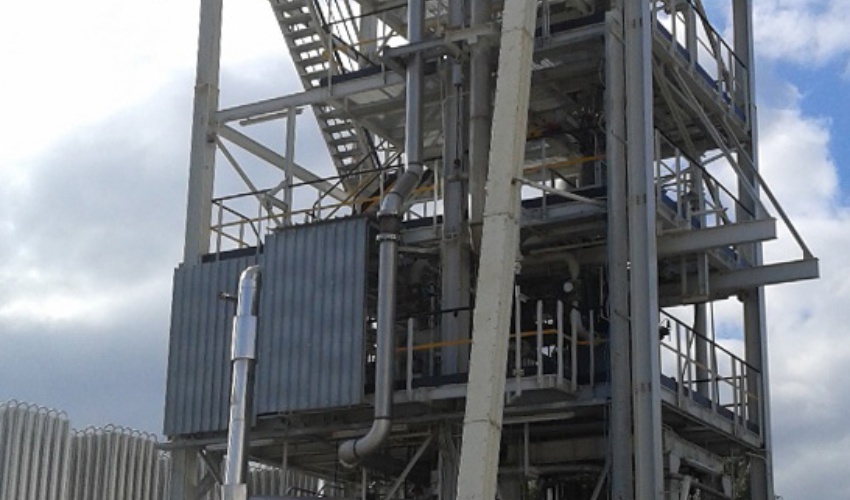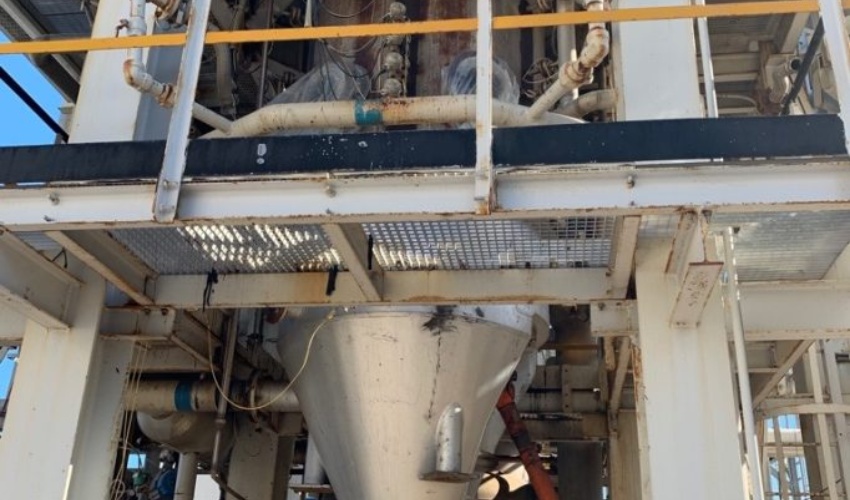Fixed-bed gasification demonstration plant
The fixed-bed gasification demonstration plant allows the treatment of different types of coals and biomasses in order to carry out gasification tests with different fuels.
The fixed-bed gasification demonstration plant is designed to process different types of coals (up to 5 MW thermal) and biomasses and has been utilized, since 2012, to carry out gasification tests with different fuels.
It mainly consists of three sections:
- A fixed-bed gasification reactor with up-draft technology;
- A gas cleaning system (clean-up) involving an equi-current scrubber;
- A torch to burn the produced syngas.
The plant is used for the study and optimization of the gasification process with different fuels: initially with some types of coal, subsequently for the co-gasification of coal and biomass and, in recent years, of biomass alone.
The latter are woody in nature (pine, eucalyptus or cypress wood chips, depending on availability).
The main goal is to identify the operating conditions for the production of a syngas with a high calorific value, optimizing the chemical-physical conversion from solid to gaseous fuel.
The gasification system is of the up-draft fixed-bed type, air powered and designed to operate at near-atmospheric pressure.
The reactor has an internal diameter of 1300 mm and an overall high of 2800 mm (with a maximum bed height of 2400 mm).
The fuel is introduced through a hopper located at the top of the reactor, which is followed by a Y-shaped conduit, supplemented by three guillotine valves to manage the timing of the loading.
This is done automatically by means of a “Redler” chain conveyor: the material to be gasified is introduced into the lower hopper through a forklift and, thanks to the conveyor, gets transported into the upper hopper where four loading cells are located, each of which can handle up to 150 kg of fuel.
The gasification reactor has steel walls inside that are cooled by a sleeve in which water circulates.
The cooling system of the gasifier is complemented by an upper cylindrical body and a forced-flow air condenser.
The thermal profile inside the gasifier is monitored with the aid of 36 thermocouples positioned on six different levels of the reactor walls.
The fuel bed rests on top of a metal grid that allows the ash to be discharged through a system consisting of several concentric planes.
The ignition phase is carried out with the assistance of six ceramic irradiators arranged in a circular manner at a height of 500 mm from the bottom of the reactor.
The gasifying agents necessary to the functioning of the reactor are process air and steam, generated respectively by a blower with a maximum flow rate of 1100 m3/h and two boilers capable of producing a flow rate of 250 kg/h each, at a pressure of 4 bar.
The residual inert material from the gasification process is collected, in the form of ash, at the bottom of the reactor: through a rotation of the grid, it gets discharged and sent to landfill.
The following table summarizes some constructive and operational details.
- Nominal output 5 MWth
- Nominal biomass throughput 360 kg/h
- Reactor inner diameter 1300 mm
- Reactor height 2800 mm
- Maximum bed temperature 800-900 °C
- Syngas output temperature 300 °C
- Syngas calorific value 4-5 MJ/kg
- Cold gas efficiency 80-85%
Inside the gasifier, the solid fuel gradually moves towards the bottom of the reactor and comes into contact with the gasifying agents, triggering the processes of drying, devolatilization, pyrolysis, gasification and (partial) combustion, the latter at a temperature in the range of 800-900 °C.
The gasifying agents, on the other hand, travel upwards through the fuel bed: the oxygen reacts in the lower part of the bed, while nitrogen travels upwards dragging the produced synthesis gas (consisting mainly of a mixture of H2, CO, CO2 and traces of CH4, as well as nitrogen itself), which leaves the reactor at around 300 °C with a lower heating value in the order of 4-5 MJ/kg.
The addition of steam promotes the water-gas shift conversion reaction, resulting in an enrichment of the gas in hydrogen.
The overall efficiency of the gasification process (commonly referred to as “cold gas efficiency” and given by the ratio of the chemical power associated with the produced syngas and the power associated with the input fuel) is in the order of 80-85%, thanks to the countercurrent energy exchanges.
The scrubber is a scrubbing tower whose purpose is to wash the syngas through a stream of equi-current water.
The process enables the reduction of the gas temperature (from roughly 200-300 °C to 30-50°C), the removal of dust and heavy hydrocarbons (tar).
Attached to the scrubber is a storage tank that allows an efficient volume of water to be constantly available for flushing the gas.
In the lower part of the storage tank there is a valve for the discharge of the sedimented fraction, an inlet for the reintegration of the water evaporated during washing in the scrubber and another for sending the discharged water as effluent: this is collected in a drain on board of the plant and is subsequently conveyed to a waste treatment system, also located in the Pilot Platform area.
Finally, in the torch, takes place the combustion of the syngas produced in the gasifier and washed in the scrubber.
The operating parameters of the gasification process are set and monitored remotely at a control room, located in the adjacent area to the Pilot Platform.
The composition of syngas (both at the exit of the gasifier and the scrubber) can be determined continuously through an analytical cabinet: the point concentrations of the main gas components, i.e. hydrogen, carbon monoxide, carbon dioxide, methane and hydrogen sulfide are determined.
The concentration of oxygen is also monitored (however, only present in traces in the syngas, but indicative of the efficacy of the process).
The data from the conducted experimental tests are recorded and analyzed in order to implement, during the course of the test and at its conclusion, actions to improve the quality of the process based on the expected results.



